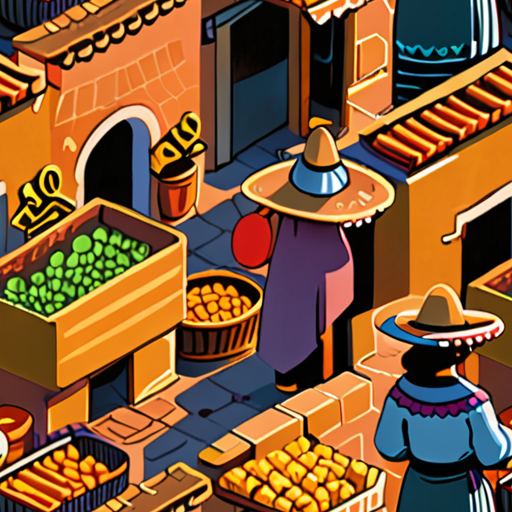For many food enthusiasts, the allure of mole sauce lies in its rich, complex flavors and versatility in pairing with various proteins and sides. However, crafting the perfect flavorful mole sauce can be a daunting task, especially when considering the intricacies involved in achieving balance between sweetness and heat. In this comprehensive guide, we’ll delve into the secrets behind this iconic Mexican condiment, exploring what gives mole its distinctive flavor profile, debunking common misconceptions about its nutritional value, and highlighting regional variations and modern twists on traditional recipes.

What Gives Mole Its Flavor?
Mole is a complex and rich sauce originating from Mexico, characterized by its deep, velvety texture and intense flavor.
- Dried Chilies: A blend of various types of dried chilies, including ancho, mulato, and pasilla, adds depth and heat to the sauce.
- Nuts and Seeds: Almonds, pumpkin seeds, and sesame seeds contribute nutty flavors and crunchy textures.
- Dried Fruit: Raisins and apricots add sweetness and chewiness to the sauce.
- Onion and Garlic: Sauteed onions and garlic provide a savory base for the sauce.
- Spices: Cumin, coriander, and cinnamon add warmth and aromatic flavors.
- Dark Mexican Chocolate: A small amount of high-quality dark chocolate enhances the sauce’s richness and complexity.
The combination of these ingredients creates a unique and intricate flavor profile that defines mole sauce.
Understanding the Role of Each Ingredient
- Dried Chilies: They provide the foundation for the sauce’s heat level and depth of flavor.
- Nuts and Seeds: They add texture and nutty flavors, balancing out the spiciness of the chilies.
- Dried Fruit: They introduce sweetness and chewiness, offsetting the savory flavors of the onions and garlic.
- Spices: They warm up the sauce and add aromatic notes, complementing the chocolate’s richness.
- Dark Mexican Chocolate: It elevates the sauce’s complexity and richness, tying together the various flavors.
Crafting the Perfect Mole Sauce
To create an exceptional mole sauce, it’s essential to balance the flavors and textures of each ingredient.
- Roast the Dried Chilies: To enhance their flavor and aroma.
- Taste and Adjust: Regularly taste the sauce and adjust the seasoning to achieve the perfect balance of flavors.
- Add the Nuts and Seeds: Toasting them before adding them to the sauce can enhance their flavors and textures.
- Incorporate the Dark Mexican Chocolate: Use high-quality chocolate to elevate the sauce’s richness and complexity.
By understanding the role of each ingredient and carefully balancing their flavors and textures, you can create an exceptional mole sauce that showcases the rich heritage of Mexican cuisine.
Is Mole Sauce Unhealthy?
Mole sauce is often associated with rich and decadent flavors, which may lead people to believe it’s unhealthy.
- Mole sauce is made from a variety of ingredients, including chocolate, spices, and nuts, which provide a range of essential nutrients.
- The sauce is also high in antioxidants, thanks to the presence of cocoa powder and other plant-based ingredients.
Nutritional Benefits of Mole Sauce
Mole sauce contains several key nutrients, including:
- Iron: Essential for healthy red blood cells, iron is found in many of the ingredients used to make mole sauce, including chocolate and nuts.
- Magnesium: A mineral that plays a crucial role in muscle function and nerve function, magnesium is present in many of the ingredients used to make mole sauce.
- Calcium: Important for bone health, calcium is found in dairy products and other ingredients used to make mole sauce.
- Zinc: An essential mineral that supports immune function and wound healing, zinc is present in many of the ingredients used to make mole sauce.
Healthier Options for Mole Sauce
If you’re concerned about the nutritional content of traditional mole sauce, there are several healthier options available:
- Vegetarian and vegan mole sauce: Made with plant-based ingredients, these versions of mole sauce are lower in saturated fat and higher in fiber.
- Lower-sugar mole sauce: By reducing the amount of sugar added to the sauce, you can make it a healthier option.
- Homemade mole sauce: Making your own mole sauce allows you to control the ingredients and nutritional content.
Conclusion
In moderation, mole sauce can be a part of a healthy diet. By choosing healthier options and being mindful of portion sizes, you can enjoy the rich flavors of mole sauce while minimizing its negative effects on your health.

The Different Types of Mole Sauces
I’m passionate about sharing my knowledge of traditional Mexican flavors, particularly when it comes to mole sauces. As a food enthusiast, I’ve had the pleasure of experimenting with various types of mole, each with its unique characteristics and flavor profiles. In this article, I’ll delve into the world of mole sauces, highlighting the different types and what makes them special.
Mole is a complex sauce made from a blend of spices, chilies, nuts, seeds, and chocolate, among other ingredients. The process of making mole can be time-consuming and labor-intensive, but the end result is well worth the effort. There are several types of mole sauces, each with its own distinct flavor and texture.
- Mole Negro: Also known as black mole, this type of mole is characterized by its dark color and rich, slightly bitter flavor. It’s typically made with a combination of ancho and mulato chilies, almonds, and chocolate.
- Mole Rojo: Red mole is a popular variety that gets its name from the red color of the ancho chilies used in its preparation. It has a slightly sweeter flavor than mole negro and is often served with chicken or pork.
- Mole Coloradito: This type of mole is known for its vibrant orange-red color and mild, slightly sweet flavor. It’s typically made with a combination of ancho and guajillo chilies, along with spices and nuts.
- Mole Amarillo: Yellow mole is a variation of mole rojo that uses yellow chilies instead of red ones. It has a bright, sunny color and a slightly spicy flavor.
- Mole Verde: Green mole is a lighter-colored variety that’s made with a combination of green chilies, herbs, and spices. It has a fresh, herbaceous flavor and is often served with chicken or fish.
- Mole Manchamanteles: This type of mole is named after the Spanish word for “tablecloth,” which refers to the fact that it stains clothing and tablecloths due to its intense color. It’s a rich, complex sauce made with a combination of ancho and mulato chilies, along with spices and nuts.
- Mole Chchilo: Chchilo mole is a lesser-known variety that’s made with a combination of chilies, spices, and nuts. It has a distinctive flavor that’s both spicy and slightly sweet.
Each type of mole sauce has its own unique characteristics and flavor profile, making them perfect for different dishes and occasions. Whether you’re a seasoned chef or a curious foodie, there’s a type of mole sauce out there waiting to be discovered.
Exploring the World of Mole
As a lover of traditional Mexican flavors, I’m always excited to explore new types of mole sauces. From the rich, complex flavors of mole negro to the bright, sunny colors of mole amarillo, each type of mole has something special to offer. By trying different types of mole and experimenting with new recipes, you can unlock the full potential of these incredible sauces and take your cooking to the next level.
At Panito Mole , we’re passionate about sharing our knowledge of traditional Mexican flavors and helping you discover the magic of mole sauces. Whether you’re a seasoned chef or just starting out, we invite you to join us on this culinary journey and explore the wonderful world of mole.

What is the Most Popular Mole?
Moles have been a staple of Mexican cuisine for centuries, and among the many variations, there is one that stands out as the most popular: Mole Poblano.
Mole Poblano originates from Puebla, Mexico, and its rich flavor profile is a result of blending various chile peppers, nuts, spices, sugar, and chocolate.
This complex sauce typically consists of around 20 ingredients, making it a true masterpiece of Mexican cuisine.
As a fan of authentic Mexican flavors, I can attest that Mole Poblano is a game-changer for any dish it’s paired with.
At Panito Mole, we’re passionate about sharing our knowledge of traditional Mexican cuisine, and Mole Poblano is definitely one of our specialties.
Whether you’re a seasoned chef or just starting to explore the world of Mexican cooking, Mole Poblano is a must-try.
So, what makes Mole Poblano so special? Let’s dive into the details:
- Nutritious ingredients: Mole Poblano is made with a variety of nutritious ingredients, including chile peppers, nuts, and spices.
- Complex flavor profile: The combination of ingredients creates a rich, complex flavor profile that’s both savory and slightly sweet.
- Adaptable: Mole Poblano can be used as a sauce for meats, vegetables, or even as a dip.
Other notable mentions include Oaxacan Mole Negro and Yucatecan Mole Rojo, which are also delicious and worth trying.
However, Mole Poblano remains the most popular and widely recognized variation of mole sauce.
For a truly authentic experience, try making your own Mole Poblano from scratch using our recipe guide.
With its rich history and cultural significance, Mole Poblano is a true gem of Mexican cuisine that deserves to be celebrated.
At Panito Mole, we’re dedicated to sharing our passion for traditional Mexican cuisine with you, and we hope you enjoy exploring the world of moles as much as we do!
Which Mole is Sweeter?
Moles are complex sauces originating from Mexico, each with its unique flavor profile.
- Mole Poblano : A rich and chocolate-based sauce, often considered one of the most iconic moles in Mexican cuisine.
- Red Mole : Characterized by its deep red color and robust flavor, resulting from the combination of chilies, spices, and nuts.
- Oaxacan Mole : Known for its diverse variations, ranging from sweet and spicy to smoky and savory.
- Panito Mole : A type of mole originating from the state of Puebla, famous for its delicate balance of flavors and textures.
The sweetness level of a mole can vary greatly depending on the ingredients and proportions used in its preparation.
- Chocolate-based moles , like Mole Poblano, tend to have a deeper, richer flavor profile, which may contribute to their perceived sweetness.
- Nut-based moles , such as those found in Oaxacan Mole, often incorporate sweet ingredients like raisins or plantains, adding to their overall sweetness.
- Spice-level moles , like Red Mole, may have a more pronounced heat, which can balance out the sweetness of other ingredients.
When comparing the sweetness levels of various moles, it’s essential to consider the individual ingredients and their proportions.
For instance, a mole with a high concentration of chocolate or nuts may be perceived as sweeter than one with a more balanced blend of ingredients.
In contrast, a mole with a strong emphasis on spices or chilies may have a more pronounced heat, potentially offsetting any sweetness present.
Ultimately, the perception of sweetness in a mole depends on personal taste preferences and the specific characteristics of the sauce.
Experimenting with different types of moles and adjusting ingredient ratios can help you find the perfect balance of flavors to suit your taste buds.
At Panito Mole , we offer a variety of mole recipes and cooking techniques to help you explore the world of Mexican cuisine and discover your favorite moles.

What is the Number One Mole?
The term “mole” has two distinct meanings, often causing confusion among scientists and non-scientists alike.
- In chemistry, a mole refers to a unit of measurement representing 6.02214076 × 10^23 particles, such as atoms or molecules.
- In Mexican cuisine, a mole is a rich and complex sauce made from a blend of spices, chilies, nuts, seeds, and chocolate, typically served over meat or vegetables.
For the purpose of this discussion, we’ll focus on the culinary aspect of a mole.
A Brief History of Mole
Mole originated in Mexico, specifically in the city of Puebla, where it was created by the Aztecs and later refined by Spanish conquistadors.
- The name “mole” is derived from the Nahuatl word “molli,” meaning mixture or blend.
- There are several types of mole, including Oaxacan mole negro, Puebla-style mole poblano, and Yucatecan mole manchamantel.
Key Ingredients in a Traditional Mole
A classic mole recipe consists of a combination of ingredients, including:
- Chilies, such as ancho, mulato, and pasilla
- Nuts, like almonds and pecans
- Seeds, including coriander and cumin
- Spices, including cinnamon and cloves
- Chocolate, typically in the form of cocoa powder or dark chocolate
- Herbs, such as oregano and thyme
Preparing a Delicious Mole Sauce
To create a mouth-watering mole sauce, follow these steps:
- Roast the chilies, nuts, and seeds to enhance their flavor and aroma.
- Grind the roasted ingredients into a fine paste using a blender or molcajete.
- Add the spice blend, chocolate, and herbs to the paste, mixing well.
- Simmer the sauce over low heat, stirring occasionally, until it thickens and develops a rich, velvety texture.
Conclusion
Mole is a beloved dish in Mexican cuisine, offering a unique blend of flavors and textures that delight the senses.
Whether you’re a seasoned chef or a curious cook, experimenting with mole recipes can lead to exciting discoveries and delicious creations.
So, go ahead and explore the world of mole – your taste buds will thank you!

0 Comments